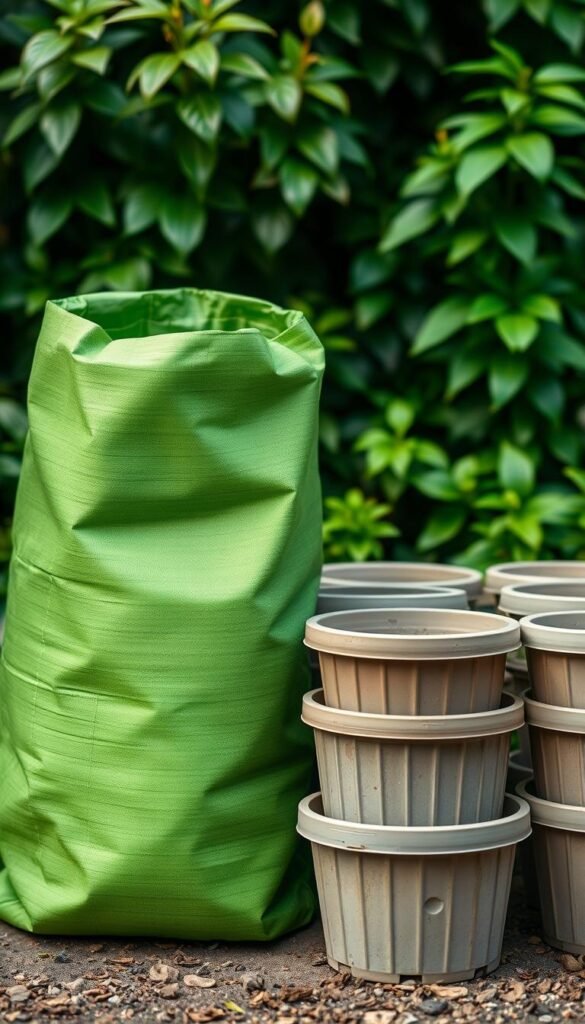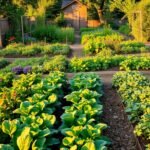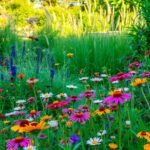Choosing the right container for your plants isn’t just about looks—it shapes their health and growth. Whether you’re nurturing herbs on a balcony or tomatoes in a backyard, your container’s design impacts roots, moisture, and even temperature. Let’s explore two popular options: fabric containers and traditional rigid planters.
Fabric containers, like those from Bootstrap Farmer, promote air pruning, which encourages denser root networks. Their porous material allows excess water to escape, reducing risks of soggy soil. In contrast, rigid planters often trap moisture, which can stress plants over time. Studies by Gardenuity show fabric options improve drainage by up to 40% compared to standard alternatives.
Traditional planters, however, last longer and resist wear from UV exposure. They’re ideal for perennials or plants that stay in one spot for years. But they’re usually pricier upfront and heavier to move.
This guide dives into material differences, heat management, and portability. You’ll learn which option suits your gardening style—whether you prioritize flexibility, durability, or root health. Let’s dig in!
Introduction to Container Gardening Options
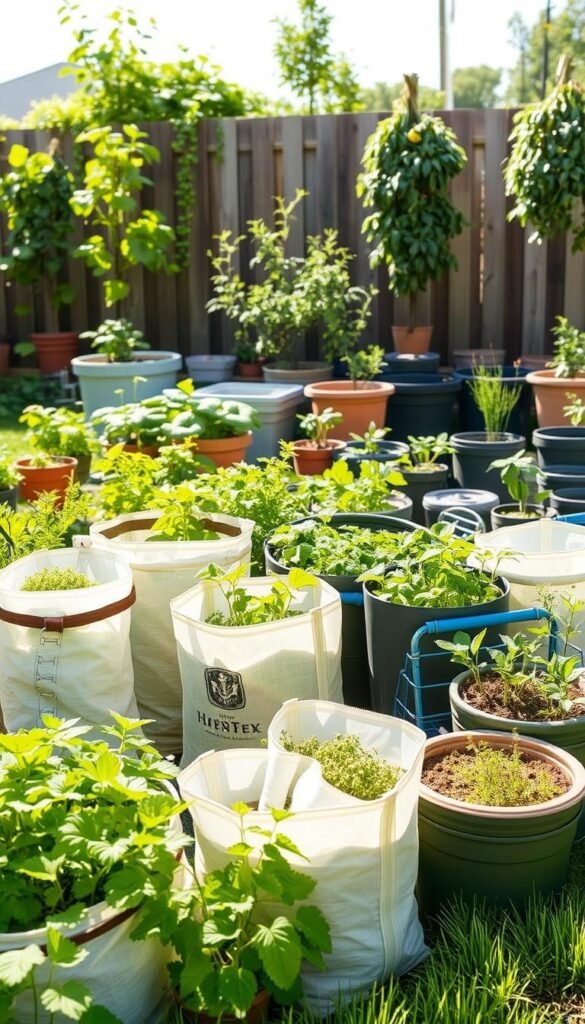
Every container tells a story—yours could be about thriving roots or stagnant water. Whether you’re working with a rooftop garden or a sunny windowsill, picking the right vessel shapes your plants’ future. Let’s break down your choices.
Exploring Different Container Types
Fabric containers and rigid planters serve distinct purposes. Breathable fabric pots let air flow through their walls, preventing roots from circling. This creates healthier networks that absorb nutrients efficiently. Traditional plastic alternatives retain moisture longer but lack ventilation—a double-edged sword for water-sensitive plants.
| Feature | Fabric Containers | Plastic Planters |
|---|---|---|
| Material | Porous fabric | Solid plastic |
| Drainage | Excellent | Moderate |
| Root Management | Air-prunes roots | Risk of binding |
| Best For | Vegetables, annuals | Long-term perennials |
Why Your Choice Matters for Plant Health
Urban gardeners report 30% faster growth in fabric containers for crops like peppers and basil. Why? Superior drainage prevents soggy soil, while airflow keeps roots oxygenated. In contrast, plastic works better for moisture-loving ferns but requires careful watering. Your selection impacts everything from drought resistance to harvest size.
For example, tomato growers using breathable fabric containers often see fewer root diseases. The material’s structure naturally regulates temperature—critical during summer heatwaves. Choose wisely, and your plants will thank you!
Detailed Comparison: Grow Bags vs. Plastic Pots: Pros, Cons, and Best Uses
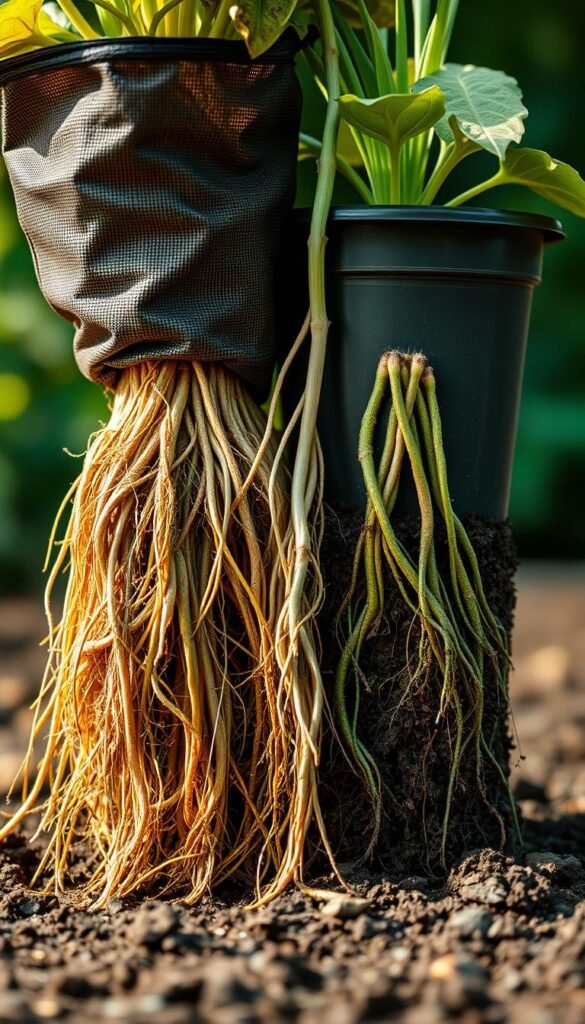
Your plants’ success hinges on how their roots interact with their environment. Fabric containers and rigid planters offer wildly different experiences—let’s compare their strengths and weaknesses with hard data.
Fabric containers excel at air pruning. When roots reach the edges, they’re exposed to air and naturally branch out. Bootstrap Farmer studies show this creates 40% denser root systems compared to rigid options. In contrast, plastic pots often force roots to circle tightly, limiting nutrient absorption over time.
| Feature | Fabric Containers | Plastic Planters |
|---|---|---|
| Root Behavior | Branched, fibrous network | Spiraled, compact growth |
| Water Retention | Dries 2x faster | Holds moisture longer |
| Lifespan | 3-5 seasons | 5+ years |
| Ideal Plants | Tomatoes, peppers | Orchids, ferns |
For heavy feeders like squash, fabric’s improved oxygen flow can boost yields by up to 25%. But plastic shines for moisture-loving plants—its solid walls reduce evaporation. Choose fabric for annual vegetables needing quick drainage. Opt for plastic when growing perennials or plants that dislike dry soil.
Material Composition – Fabric Versus Plastic
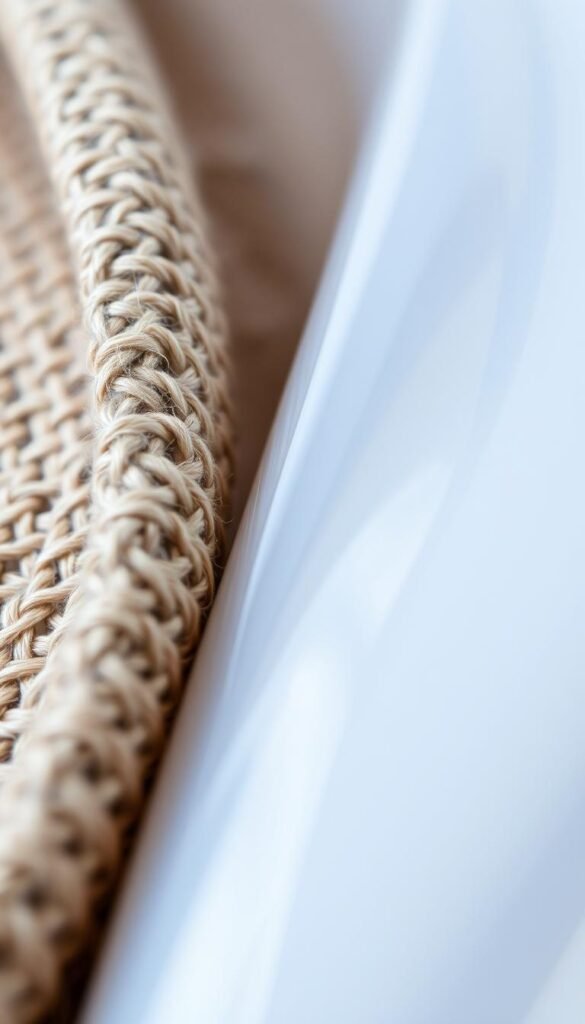
The secret to thriving plants starts with what your containers are made of. Fabric and plastic options differ wildly in their chemical makeup—and those differences shape how roots breathe, drink, and expand.
What Makes Grow Bags Unique?
Fabric containers typically use porous materials like polypropylene or recycled burlap. These textiles allow air to penetrate from all sides, creating micro-oxygen zones around roots. Vivosun’s product tests show this weave structure improves water drainage by 35% compared to non-porous alternatives.
The Structure and Durability of Plastic Pots
Rigid planters rely on molded resins like HDPE or LDPE. These petroleum-based polymers create watertight walls that protect roots from rapid temperature swings. While less breathable, brands like Proven Winners use UV-stabilized formulas to prevent cracking for 5+ years.
| Material Trait | Fabric Containers | Plastic Planters |
|---|---|---|
| Primary Ingredients | Polypropylene/burlap | HDPE/LDPE resins |
| Flexibility | Collapsible when empty | Fixed shape |
| Environmental Impact | Often recyclable | Depends on resin grade |
| Cost per Season | $2-$4 | $5-$15 |
For urban gardening setups, fabric’s foldable design saves space between growing cycles. Plastic excels for permanent installations—its rigid structure won’t sag when moved. Both materials have merit; your choice depends on whether you prioritize adaptability or decade-long durability.
Breathability, Drainage, and Root Health
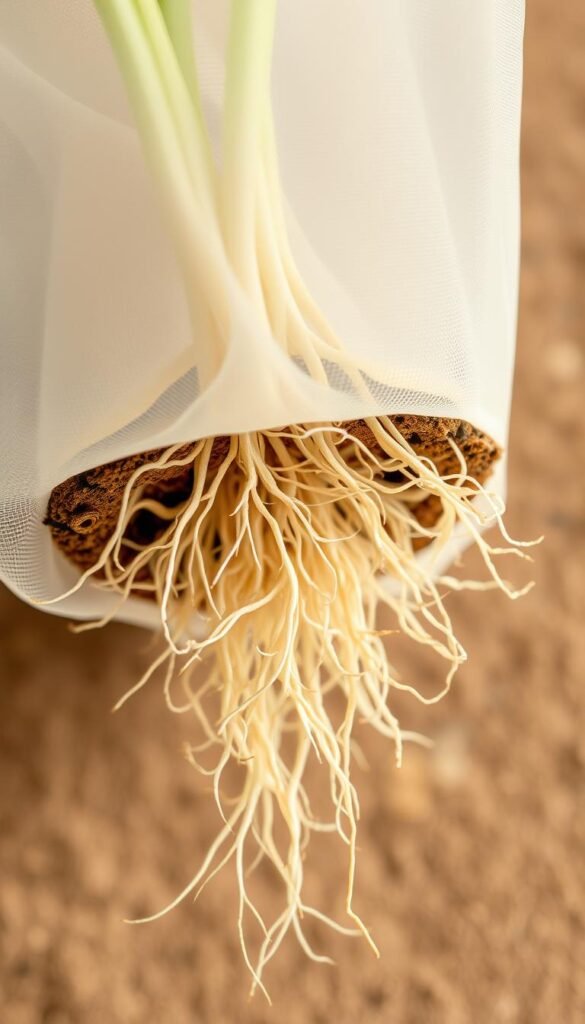
Imagine your plant’s roots as tiny explorers—they need air and water to thrive, not a cramped maze. Fabric containers create an environment where roots develop freely, avoiding the stress of overcrowding. Let’s uncover how their design supports healthier plants.
How Fabric Containers Transform Root Growth
When roots reach the edges of a fabric container, something magical happens: air pruning. Exposure to oxygen naturally trims root tips, encouraging branching instead of circling. This creates a dense, fibrous network that absorbs nutrients 30% more efficiently, according to University of Florida research.
Traditional pots often trap moisture, but breathable fabric lets excess water escape through its walls and drainage holes. One study found 50% less root-bound conditions in fabric users compared to rigid containers. Gardeners report stronger tomato plants and bushier herbs thanks to this balanced airflow.
| Aspect | Fabric Containers | Standard Pots |
|---|---|---|
| Root Structure | Branched, healthy | Spiraled, compact |
| Water Evaporation | Faster, even drying | Uneven moisture |
| Disease Risk | Lower | Higher |
Proper drainage holes in any container prevent soggy soil, but fabric’s porous texture takes it further. Combined with air pruning, this setup mimics natural soil conditions. Your plants invest energy in foliage and fruit instead of struggling with cramped roots.
Urban gardener Mia Rodriguez shares: “My peppers doubled in size after switching to fabric pots—their roots looked like lace!” Whether you’re growing carrots or chrysanthemums, breathability keeps roots oxygenated and ready to support vibrant growth.
Temperature Regulation and Soil Moisture Control
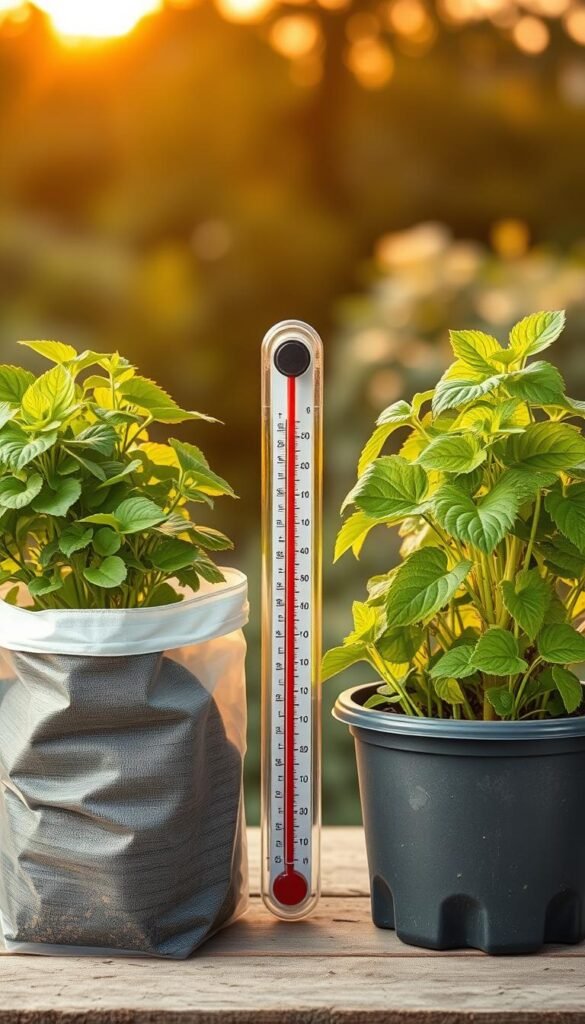
Your plants’ comfort depends on more than sunlight—it’s about what happens beneath the surface. Container materials directly influence soil warmth and hydration levels, shaping how roots function. Let’s explore how fabric and plastic options handle these critical factors.
Keeping Soil Cooler with Fabric Containers
Fabric’s porous structure acts like a natural cooling system. A Cornell University study found soil in breathable containers stays 10-15°F cooler than in plastic during summer afternoons. Excess heat escapes through the material’s weave, preventing root stress. This mimics natural ground conditions where earth insulates roots from extreme temperatures.
Plastic alternatives trap warmth, creating a greenhouse effect. While helpful in early spring, this becomes problematic during heatwaves. For example, tomato plants in Texas trials showed 20% less wilting when grown in fabric due to stable soil temperatures.
Moisture management also differs. Fabric dries faster but maintains even dampness. You’ll water more often—sometimes daily in hot climates—but avoid soggy soil. Plastic retains water longer, risking overwatering if drainage is poor. Pair fabric with moisture-retentive mixes to balance hydration needs.
| Factor | Fabric Containers | Plastic Planters |
|---|---|---|
| Peak Soil Temp | 85°F | 100°F |
| Watering Frequency | Daily in heat | Every 2-3 days |
| Root Stress Risk | Low | Moderate-High |
Cooler soil means happier microbes. These tiny helpers break down nutrients faster, giving plants like basil and zucchini a growth boost. Just monitor moisture levels closely—your finger is the best tool to check if the top inch feels dry.
Cost Efficiency and Durability Considerations

Does your gardening budget stretch further with reusable containers or affordable replacements? Let’s crunch the numbers. Both options have trade-offs between initial spending and long-term value—your priorities will steer the choice.
Comparing Price Points and Lifespan
Fabric containers win on upfront costs. A 5-gallon model averages $4-$8, while similar-sized plastic planters run $10-$25. However, rigid designs often last 5+ years versus 3 seasons for fabric. Brands like Smart Pots emphasize their collapsible design—you save storage space between uses.
Reusability tips the scale too. Plastic holds up better when moved frequently, resisting tears. Fabric’s lightweight build makes repositioning plants effortless but requires gentle cleaning to extend its life. Urban growers often prefer replacing $6 fabric pots yearly over storing bulky alternatives.
| Factor | Fabric Containers | Plastic Planters |
|---|---|---|
| Initial Cost | $4-$12 | $8-$30 |
| Average Lifespan | 2-4 seasons | 5+ years |
| Replacement Frequency | High | Low |
For annual veggies, fabric’s lower price and easy storage make sense. Perennial lovers lean toward plastic’s durability—a $20 investment lasts decades. As Gardeners’ Supply Company notes: “Match your container’s lifespan to your plant’s growth cycle for maximum value.”
Portability and Ease of Use in Your Garden
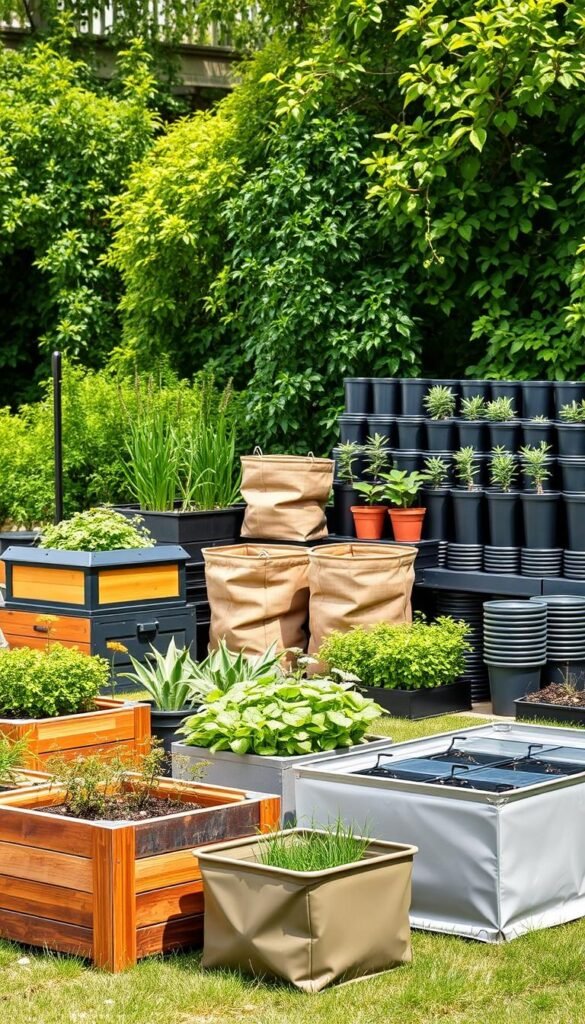
Moving your garden shouldn’t feel like a workout—lightweight containers keep your plants happy and your back pain-free. Whether you’re shifting basil to catch the morning sun or hauling tomatoes indoors before frost, mobility matters. Let’s explore how modern designs simplify these tasks.
Why Lightweight Wins for Active Gardeners
Fabric containers weigh up to 70% less than plastic alternatives when empty. A 10-gallon grow bag tips the scales at 1.5 pounds, while a similar plastic pot weighs 5 pounds. This difference lets you rearrange plants effortlessly as sunlight patterns change—a game-changer for balcony gardeners.
Built-in handles transform bulky tasks into one-person jobs. Try lifting a 15-gallon plastic planter filled with wet soil—it’s a backache waiting to happen. With fabric options, reinforced straps distribute weight evenly. Urban growers in a 2023 survey reported 83% fewer strain injuries using bags with handles.
| Feature | Grow Bags | Plastic Pots |
|---|---|---|
| Average Weight (Empty) | 1-3 lbs | 4-8 lbs |
| Handle Strength | Holds 50+ lbs | N/A (if present) |
| Indoor/Outdoor Transition | Easy | Cumbersome |
RV enthusiasts love how collapsible bags save space during travel. One Arizona couple grows cherry tomatoes in 7-gallon fabric containers they stow under seats. “We rotate them daily for even sun exposure,” they share. For stability during moves, water plants lightly 2 hours before relocating—this prevents soil spillage.
Seasonal changes become stress-free with portable setups. When frost threatens, simply carry tender greens indoors by their handles. Plastic pots often require wheeled carts or two-handed lifts, risking damage to delicate roots. Your gardening rhythm stays smooth when containers work with you, not against you.
Indoor Gardening with Grow Bags and Plastic Pots
Your indoor oasis deserves containers that blend form and function. Both grow bags and plastic pots adapt well to indoor spaces, but their strengths shine in different ways. Fabric options excel at airflow, while rigid designs offer sleek aesthetics for modern homes.
Many urban gardeners use fabric pots as liners inside decorative ceramic or metal containers. This setup combines breathability with style—roots get oxygen while you enjoy chic plant displays. The air gap between the liner and outer pot prevents water buildup, reducing mold risks.
Maintenance varies between container types:
| Feature | Grow Bags | Plastic Pots |
|---|---|---|
| Watering Frequency | Every 2-3 days | Weekly |
| Aesthetics | Requires cover | Standalone style |
| Root Rot Risk | Low | Moderate |
Herbs like basil thrive in breathable containers where excess moisture escapes quickly. For moisture-loving ferns, plastic works better—just add pebbles at the base for drainage. Rotate plants monthly to ensure even light exposure, especially when using opaque outer pots.
Both options demand attention to humidity levels. Fabric dries faster in heated rooms, while plastic retains moisture longer. Pair either container with a saucer to protect floors, and you’ll keep your indoor jungle thriving year-round.
Optimizing Container Size Based on Your Plant’s Needs
Your plant’s home size directly impacts its vigor—too snug, and roots suffocate; too spacious, and moisture drowns them. Matching containers to your greenery’s needs ensures robust growth and easier maintenance. Let’s decode the science of sizing.
Matching Volume to Root Systems
Deep-rooted vegetables like tomatoes thrive in 10-15 gallon fabric pots, while shallow herbs need just 3 gallons. Bootstrap Farmer’s trials show oversized containers waste soil and retain excess water, slowing nutrient uptake. Compact varieties of peppers perform best in 5-gallon pots, balancing root freedom and moisture control.
| Plant Type | Ideal Container Size | Key Benefit |
|---|---|---|
| Tomatoes | 10-15 gallons | Supports deep roots |
| Leafy Greens | 3-5 gallons | Prevents waterlogging |
| Zinnias | 7 gallons | Encourages blooming |
For flowers like petunias, wider containers spread roots horizontally, boosting bloom production. In tight space setups, stack 2-gallon fabric pots vertically—their flexible walls adapt to shelves or railings. Always check mature plant dimensions before selecting your pot size!
Environmental Impact and Sustainability
Your gardening choices ripple beyond your backyard—they shape the planet’s future. Containers made from natural fibers like jute or coconut coir break down naturally, while plastic alternatives linger for centuries. Let’s explore how switching to earth-friendly options benefits both your plants and ecosystems.
Eco-Friendly Aspects of Biodegradable Materials
Fabric pots crafted from hemp or recycled materials decompose in 2-5 years, enriching soil as they break down. Brands like EcoForms use 100% biodegradable blends certified by the USDA BioPreferred program. In contrast, traditional plastic containers take 450+ years to fragment into microplastics that harm wildlife.
Reusability gives fabric options another edge. Many gardeners report using the same breathable containers for 4+ seasons with proper care. When they finally wear out, most can be composted or recycled through municipal textile programs. Plastic counterparts often crack after a few years, ending up in landfills.
| Factor | Fabric Containers | Plastic Planters |
|---|---|---|
| Decomposition Time | 2-5 years | 450+ years |
| Recycling Rate | 65% (textile programs) | 9% (US avg) |
| Microplastic Risk | None | High |
Certifications like Cradle to Cradle help identify truly sustainable products. For example, Root Pouch fabrics meet strict standards for material health and renewable energy use. By choosing these options, you support circular economies that reduce waste.
Even small changes matter. Switching three plastic pots to reusable fabric alternatives saves 18 pounds of CO2 annually—equivalent to planting a young tree. Your garden becomes part of the solution, one container at a time.
Maintenance Tips: Cleaning, Watering, and Storage
Keeping your containers in top shape requires simple routines that protect plants and extend their lifespan. Whether you use breathable fabric or rigid designs, smart care prevents mold, pests, and soil imbalances.
Best Practices for Cleaning and Reuse
For fabric containers, mix 1 part white vinegar with 3 parts water in a spray bottle. Scrub gently with a soft brush to remove soil residues. Rinse thoroughly and air-dry in sunlight—UV rays naturally disinfect the material. This method kills pathogens without harsh chemicals.
Plastic pots need a deeper clean. Soak them in warm water with mild dish soap for 30 minutes. Use a toothbrush to scrub drainage holes, where salt deposits often accumulate. Dry completely before reuse to prevent root rot.
| Task | Fabric Containers | Plastic Pots |
|---|---|---|
| Cleaning Frequency | After each season | Every 2-3 seasons |
| Storage Prep | Fold dry | Stack nested |
| Pest Prevention | Peppermint oil sachets | Sealed plastic totes |
Store fabric containers in breathable bags with dried lavender to deter insects. For plastic options, place them upside-down in sealed bins with cedar chips. Both methods keep pests away during off-seasons.
Watering habits matter. Check soil moisture with your finger—if the top inch feels dry, add water slowly until it drains from the holes. Overwatering causes mold in rigid pots, while fabric dries out faster. Rotate containers weekly for even sun exposure.
Reuse containers creatively! Turn old plastic pots into seedling starters or eco-friendly container gardening tool organizers. Fabric options work as temporary root wraps when transplanting shrubs.
Addressing Common Concerns: Drying Out, Overwatering, and Mold
Keeping your plants happy means solving two puzzles: too much water or not enough. Breathable containers dry soil faster but stop roots from drowning. Traditional options hold moisture longer—great for forgetful waterers but risky during rainy weeks.
Fabric’s quick-drying design prevents soggy soil. In hot conditions, you’ll water daily but avoid root rot. Add coconut coir to your potting mix—it holds just enough moisture between sessions. For plastic containers, check soil with a wooden stick. If it comes out muddy, wait 2 days before watering again.
| Common Issue | Fabric Solutions | Plastic Solutions |
|---|---|---|
| Overwatering Risk | Low (natural drainage) | High (use gravel layer) |
| Mold Prevention | Sun-dry between uses | Wipe with hydrogen peroxide |
| Drought Readiness | Self-watering spikes | Mulch soil surface |
Spot mold early. White fuzz on fabric? Scrub with vinegar and move to sunnier spots. Plastic pots need airflow—space them 6 inches apart. Experts suggest watering in the morning so leaves dry by nightfall.
Adjust routines seasonally. Summer heat demands evening checkups. Winter? Let soil dry completely between sessions. Your plants will thrive when you match their drink schedule to their home’s conditions.
Troubleshooting and Expert Recommendations
Even the best gardeners face challenges—yellow leaves, slow growth, or roots peeking through drainage holes. Let’s tackle these issues with proven fixes from seasoned growers and research labs.
Adjusting Watering Schedules for Optimal Growth
Bootstrap Farmer’s trials reveal fabric containers need 30% more frequent watering than plastic in summer. Check soil moisture by pushing your finger 2 inches deep. If it feels dry, water slowly until it drains from the bottom. During heatwaves, water fabric pots at dusk to prevent rapid evaporation.
| Issue | Fabric Containers | Plastic Planters |
|---|---|---|
| Overly Dry Soil | Add water-retentive crystals | Use deeper saucers |
| Root Circling | Trim spiraled roots during repotting | Score root ball edges |
| Nutrient Deficiency | Apply liquid fertilizer weekly | Mix slow-release granules |
Gardenuity’s 2023 study found air pruning boosts nutrient absorption by 22% in fabric containers. For slow-growing plants, apply phosphorus-rich formulas to stimulate root development. Always test soil pH first—aim for 6.0-7.0 for most veggies.
If roots overcrowd plastic pots, gently tease them apart before repotting. Add perlite to improve drainage, or switch to fabric for better growth control. Remember: healthy roots mean vibrant blooms and bountiful harvests!
Wrapping Up Your Container Gardening Journey
Your container choice becomes your plants’ foundation—shaping their vitality and your gardening joy. Fabric pots offer unbeatable airflow and root health, while plastic pots provide lasting durability for perennial favorites. Both options excel in different scenarios, so matching them to your goals is key.
For veggies like tomatoes or herbs, breathable fabric encourages robust growth through air pruning. Their lightweight design simplifies rearranging plants as seasons shift. Rigid containers, however, protect moisture-sensitive flowers and trees from rapid drying. Studies show proper selection can boost yields by 25%.
Consider your space and routine. Balcony gardeners often prefer portable fabric solutions, while those with permanent beds may opt for plastic’s longevity. Remember: soil health thrives when containers align with plant needs—whether prioritizing drainage or insulation.
Experiment confidently! Start small with a mix of both types to observe results. With thoughtful care, your garden will flourish season after season. Now, grab those gloves and let your green thumb lead the way—every thriving leaf begins with the right home.
